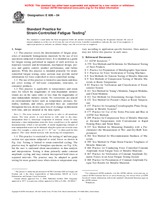Potřebujeme váš souhlas k využití jednotlivých dat, aby se vám mimo jiné mohly ukazovat informace týkající se vašich zájmů. Souhlas udělíte kliknutím na tlačítko „OK“.
ASTM E606-04
Standard Practice for Strain-Controlled Fatigue Testing
Automaticky přeložený název:
Standardní praktiky pro Strain - Controlled testování únavy
NORMA vydána dne 1.10.2004
Informace o normě:
Označení normy: ASTM E606-04
Poznámka: NEPLATNÁ
Datum vydání normy: 1.10.2004
Kód zboží: NS-47389
Počet stran: 16
Přibližná hmotnost: 48 g (0.11 liber)
Země: Americká technická norma
Kategorie: Technické normy ASTM
Anotace textu normy ASTM E606-04 :
Keywords:
ICS Number Code 77.040.10 (Mechanical testing of metals)
Doplňující informace
| 1. Scope | ||||||||||||||||||||||||||||||||||||||||||||||
|
1.1 This practice covers the determination of fatigue properties of nominally homogeneous materials by the use of test specimens subjected to uniaxial forces. It is intended as a guide for fatigue testing performed in support of such activities as materials research and development, mechanical design, process and quality control, product performance, and failure analysis. While this practice is intended primarily for strain-controlled fatigue testing, some sections may provide useful information for force-controlled or stress-controlled testing. 1.2 The use of this practice is limited to specimens and does not cover testing of full-scale components, structures, or consumer products. 1.3 This practice is applicable to temperatures and strain rates for which the magnitudes of time-dependent inelastic strains are on the same order or less than the magnitudes of time-independent inelastic strains. No restrictions are placed on environmental factors such as temperature, pressure, humidity, medium, and others, provided they are controlled throughout the test, do not cause loss of or change in dimension with time, and are detailed in the data report. Note 1—The term inelastic is used herein to refer to all nonelastic strains. The term plastic is used herein to refer only to the time-independent (that is, noncreep) component of inelastic strain. To truly determine a time-independent strain the force would have to be applied instantaneously, which is not possible. A useful engineering estimate of time-independent strain can be obtained when the strain rate exceeds some value. For example, a strain rate of 1 10 3 sec1 is often used for this purpose. This value should increase with increasing test temperature. 1.4 This practice is restricted to the testing of uniform gage section test specimens subjected to axial forces as shown in (a). Testing is limited to strain-controlled cycling. The practice may be applied to hourglass specimens, see (b), but the user is cautioned about uncertainties in data analysis and interpretation. Testing is done primarily under constant amplitude cycling and may contain interspersed hold times at repeated intervals. The practice may be adapted to guide testing for more general cases where strain or temperature may vary according to application specific histories. Data analysis may not follow this practice in such cases. |
||||||||||||||||||||||||||||||||||||||||||||||
| 2. Referenced Documents | ||||||||||||||||||||||||||||||||||||||||||||||
|
Doporučujeme:
Aktualizace technických norem
Chcete mít jistotu, že používáte pouze platné technické normy?
Nabízíme Vám řešení, které Vám zajistí měsíční přehled o aktuálnosti norem, které používáte.
Chcete vědět více informací? Podívejte se na tuto stránku.




 Cookies
Cookies
